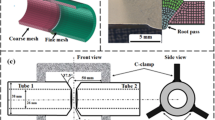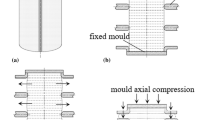Abstract
In this investigation, numerical analysis of square butt, butt with V-groove and T-weld joint configurations have been performed to estimate transient temperature distributions and residual stresses. A computational welding simulation based on a prescribed temperature approach was used that works on thermal load input derived from temperature analysis. In the thermal analysis, welding heat source or torch temperature was considered as the prescribed value of temperature, which helps in simulating real welding conditions. The inclusion of filler metal in the numerical analysis replicates the real welding phenomenon, which provides temperature distribution along the true distance of the joints. The maximum temperature was observed at the weld pool area and decreased in parabolic shape toward the base metal. Residual stresses were measured along the selected path (in the mid of plates) that comprises node-to-node variation of stresses in both longitudinal and transverse directions. von Mises and Tresca stress criterion was adopted to show accumulated stresses in the weld joints. It was observed that stresses accumulated in the different configurations of weld joints were below the yield strength 210 MPa of SUS304 steel. Peak values of stresses were observed at weld beads and in the nearby regions.



















Similar content being viewed by others
References
Oh, S.H., Ryu, T.Y., Park, S.H., Won, M.G., Kang, S.J., Lee, K.S., Lee, S.H., Kim, M.K. and Choi, J.B., 2015. Evaluation of J-groove weld residual stress and crack growth rate of PWSCC in reactor pressure vessel closure head. Journal of Mechanical Science and Technology, 29(3), pp.1225-1230.
Ren, X.B., Zhang, Z.L. and Nyhus, B., 2010. Effect of residual stresses on ductile crack growth resistance. Engineering Fracture Mechanics, 77(8), pp.1325-1337.
Predan, J., Pippan, R. and Gubeljak, N., 2010. Fatigue crack propagation in threshold regime under residual stresses. International journal of fatigue, 32(7), pp.1050-1056.
Y. Ye, J. Cai, X. Jiang, D. Dai, D. Deng, Influence of groove type on welding-induced residual stress, deformation and width of sensitization region in a SUS304 steel butt welded joint, Adv. Eng. Software. 86 (2015) 39–48.
Schnubel, D. and Huber, N., 2012. The influence of crack face contact on the prediction of fatigue crack propagation in residual stress fields. Engineering Fracture Mechanics, 84, pp.15-24.
G. Fu, I.L. Marcelo, M. Duan, F.E. Segen, Effect of boundary conditions on residual stress and distortion in T-joint welds, J. Constr. Steel Res. 102 (2014) 121–135.
Ju, J., Xue, F., Zhou, J., Bai, J. and Sun, L., 2016. Interface and bond strength of brazing cemented carbide K20 to alloy steel AISI 4140 by high-frequency induction. Materials and Manufacturing Processes, 31(8), pp.1052-1060.
Rong, Y., Zhang, G. and Huang, Y., 2016. Study of welding distortion and residual stress considering nonlinear yield stress curves and multi-constraint equations. Journal of Materials Engineering and Performance, 25(10), pp.4484-4494.
Ueda, Y. and Yamakawa, T., 1971. Japan Welding Society Transactions, 2.
Nozari, M.H., Ziaee, S. and Jafarpur, K., 2016. Experimental study of produced thermal stresses in thin arc welded plates: application of constructal theory in welding paths. Welding in the World, 60(1), pp.51-59.
Goldak, J.A. and Akhlaghi, M., 2006. Computational welding mechanics. Springer Science & Business Media.
Radaj, D., 2003. Welding residual stresses and distortion calculation and measurement.
Perić, M., Nižetić, S., Garašić, I., Gubeljak, N., Vuherer, T., & Tonković, Z. (2020). Numerical calculation and experimental measurement of temperatures and welding residual stresses in a thick-walled T-joint structure. In Journal of Thermal Analysis and Calorimetry. Springer International Publishing. https://doi.org/10.1007/s10973-019-09231-3
Luo, Y., Jiang, W., Zhang, Q., Wan, Y., Zhang, W.Y. and Wang, Y.J., 2016. Experimental and numerical study on the reduction of residual stress in the fillet weld by overlay welding and cutting method. 138.
Seleš, K., Perić, M., & Tonković, Z. (2018). Numerical simulation of a welding process using a prescribed temperature approach. In Journal of Constructional Steel Research (Vol. 145). https://doi.org/10.1016/j.jcsr.2018.02.012
Simulia. (2017). Abaqus Welding Interface (AWI) - User's Manual.
Abaqus/Standard, DassaultSystemes. Simulia, 2017.
Perić, M., Tonković, Z., Rodić, A., Surjak, M., Garašić, I., Boras, I. and Švaić, S., 2014. Numerical analysis and experimental investigation of welding residual stresses and distortions in a T-joint fillet weld. Materials & Design, 53, pp.1052-1063.
Zhu, X. K., & Chao, Y. J. (2002). In Computers and Structures (Vol. 80). https://doi.org/10.1016/S0045-7949(02)00040-8
Vakili-Tahami, F., & Ziaei-Asl, A. (2013). In Materials and Design (Vol. 47). https://doi.org/10.1016/j.matdes.2012.12.064
Elmesalamy, A. S., Abdolvand, H., Walsh, J. N., Francis, J. A., Suder, W., Williams, S., & Li, L. (2016). In International Journal of Pressure Vessels and Piping (Vol. 147). https://doi.org/10.1016/j.ijpvp.2016.09.007
Dean Deng, Hidekazu Murakawa (2005). In Computational Materials Science (Vol. 37, Issue 3). https://doi.org/10.1016/j.commatsci.2005.07.007
Lindgren, L.E., 2007. Computational Welding Mechanics, ISBN: 1845692217.
Deng, D., & Kiyoshima, S. (2010). In Computational Materials Science (Vol. 50, Issue 2). Elsevier B.V. https://doi.org/10.1016/j.commatsci.2010.09.025
Acknowledgements
Authors want to acknowledge the support and facilities provided by Dr. B.R. Ambedkar National Institute of Technology, Jalandhar Punjab India.
Author information
Authors and Affiliations
Corresponding author
Additional information
Publisher's Note
Springer Nature remains neutral with regard to jurisdictional claims in published maps and institutional affiliations.
Rights and permissions
About this article
Cite this article
Meena, P., Kumar, M., Singh, M. et al. Numerical Analysis of Different SUS304 Steel Weld Joint Configurations Using new Prescribed Temperature Approach. Trans Indian Inst Met 75, 1649–1668 (2022). https://doi.org/10.1007/s12666-021-02389-1
Received:
Accepted:
Published:
Issue Date:
DOI: https://doi.org/10.1007/s12666-021-02389-1




